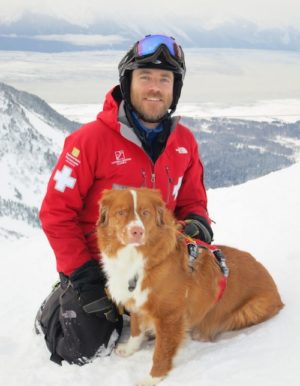
Skiers and snow boarders aren’t necessarily the only victims of an avalanche. In 2017, a staggering 29 people were killed in a torrent of snow that engulfed the Hotel Rigopiano at the foot of the Gran Sasso mountain in Italy. That said, people who recreate on a mountain in the winter and spring – “shredders” – will be more exposed to the dangers of an avalanche than others just by virtue of being there, and ski resorts have been taking proactive steps to deal with this natural phenomenon.
Enter the avalanche, or “avy” Dog. One avy dog can do the job of over 150 people in a probe line, and search a 100 x 100 meter area in less than twenty minutes, something it would take a human 3-4 hours with a course probe, and 16-18 hours with a fine probe search. Put another way, an avalanche dog can typically search 2.5 acres — roughly the area of two football fields — in about 30 minutes, something that would take 20 people eight times longer to do. Since chances of survival in a full burial avalanche decreases by 50% after just thirty minutes, timing is everything.
The first successful avalanche dog rescue in Canada took place in Fernie, British Columbia, Canada in 2000 when a buried skier was dug out alive thanks to the work of a yellow Lab named “Keno” (who was rewarded later with a big steak, cooked rare).
On average, 350 people are caught by an avalanche each winter in the United States (there were 25 fatalities in the winter of 2017 -2018 alone). Of those 350 people, 40 were buried and 28 killed. Only one in four people who are completely buried go on to survive, according to data from the Colorado Avalanche Information Center. Colorado, home of National Purebred Dog Day, regularly leads the nation in avalanche deaths with about six per year. Other states that are most prone to deadly avalanches are Alaska, Washington, Utah and Montana. For this post, we want to talk about Alaska, one of the states with a high rate of avalanche fatalities per capita.
They’re “on it!”
The Alyeska Ski Patrol Avalanche Canine Program, an affiliate of Alaska Search and Rescue Dogs, has a breed of choice for their program, and it may surprise some readers, possibly because people don’t equate ducks with avalanches. The program feels that the Nova Scotia Duck Tolling Retriever’s biddable nature, intelligence, and compact size make them an ideal candidate for ASPACP’s programs for avy and search dogs. The Tollers routinely ride ski lifts, travel on snow machines, and are carried on the shoulders of their handlers.
It takes up to three years to train an “Avy dog,” most being six to twelve months old when they start training. They learn to track a wide area of snow-covered space in a rapid zig-zag pattern, and how to search for “pools” of human scent that rise up above the snow. Learning to detect human scent under snow starts with first locating their handler buried in a shallow “grave” under the snow. That’s following by learning how to locate human scented articles and people, alerting to the find (usually with a high-pitched, excited bark), then digging out the victim.
So let’s say you’ve gone up the mountain to take a few runs. There’s always that one skier bent on showing you up, and one has just passed you. Bad news, you’re both skiing out of bounds. You don’t have much time to turn the air blue with obscenities because after the skier comes a whoosh of snow. A lot of snow. It bowls you over, and you start to fall. You just keep falling, tumbling and rolling like you’re in the spin cycle of a dryer. You finally stop, and if you’re experienced, you knew early on to put your hands in front of your face to create an air pocket in front of your mouth. Even so, breathing is like trying to inhale oxygen through a heavy cloth. Your arms are trapped, everything around you is white, and if you’re lucky, you won’t start hyperventilating from panic. And why wouldn’t you panic? If you’ve read up on avalanches, you know that on average, people are buried under a ton of snow when they’re caught in an avalanche. The snow increases in density as it settles, and it comes to resemble cement.
How overjoyed would you be to have this happen?
The take away message from this post is that Tollers may not hunt as their breed was traditionally used, but all our breeds can be repurposed, and Alaska found a way how.
Image of Brian McGorry of the Alyeska Ski Patrol Avalanche Canines with “Fundy,” a certified 8 year old Nova Scotia Duck Tolling Retriever from Sagewood Kennels in Wisconsin.
